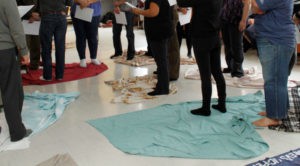 As part of Orientation Week at AlgomaU students, staff, faculty and community members were invited to participate in the KAIROS blanket exercise. Originally developed in the 1990s as a response to the Royal Commission on Aboriginal Peoples the blanket exercise is a participatory teaching too that invites participants to learn about Canadian history from an Indigenous perspective. The exercise has been updated since the 1990s to include information on more recent events such as Murdered and Missing Indigenous Women and Shannon’s Dream.
As part of Orientation Week at AlgomaU students, staff, faculty and community members were invited to participate in the KAIROS blanket exercise. Originally developed in the 1990s as a response to the Royal Commission on Aboriginal Peoples the blanket exercise is a participatory teaching too that invites participants to learn about Canadian history from an Indigenous perspective. The exercise has been updated since the 1990s to include information on more recent events such as Murdered and Missing Indigenous Women and Shannon’s Dream.
The exercise teaches about the impacts of colonialism, the loss of Indigenous land, residential schools, the sixties scoop, and numerous other facets of Canadian history that are not often taught in a classroom setting. The visual representation of Turtle Island through the use of blankets, the physical act of participants representing Indigenous people and watching the spacial and visceral damage that is caused by colonialism is a really moving and had a huge impact on participants.
This is a very unique teaching tool that can be scaled to different age groups and number of participants. I particularly liked how the session I participated in combined the national historical perspective with local responses and local experiences. A local First Nation Chief spoke about his community and the removal of resources from their land and a Shingwauk Residential School Survivor shared their experience at Shingwauk as part of the exercise’s narrative.
Given the potentially triggering nature of the content health and cultural support was available throughout the event and the scripted portion of the exercise was followed by a sharing circle which allowed participants an opportunity to reflect on the exercise and discuss the experience. Overall I think this is a great teaching tool that should be brought into more classrooms, community centers, and university campuses as a way of talking about history, ongoing inequality, and reconciliation.
